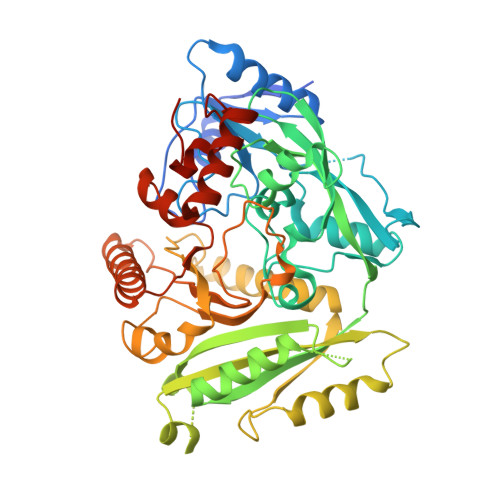Cytokinin metabolism in maize: Novel evidence of cytokinin abundance, interconversions and formation of a new trans-zeatin metabolic product with a weak anticytokinin activity.
Hluska, T., Dobrev, P.I., Tarkowska, D., Frebortova, J., Zalabak, D., Kopecny, D., Plihal, O., Kokas, F., Briozzo, P., Zatloukal, M., Motyka, V., Galuszka, P.(2016) Plant Sci 247: 127-137
- PubMed: 27095406
- DOI: https://doi.org/10.1016/j.plantsci.2016.03.014
- Primary Citation of Related Structures:
5HHZ - PubMed Abstract:
Cytokinins (CKs) are an important group of phytohormones. Their tightly regulated and balanced levels are essential for proper cell division and plant organ development. Here we report precise quantification of CK metabolites and other phytohormones in maize reproductive organs in the course of pollination and kernel maturation. A novel enzymatic activity dependent on NADP(+) converting trans-zeatin (tZ) to 6-(3-methylpyrrol-1-yl)purine (MPP) was detected. MPP shows weak anticytokinin properties and inhibition of CK dehydrogenases due to their ability to bind to an active site in the opposite orientation than substrates. Although the physiological significance of tZ side-chain cyclization is not anticipated as the MPP occurrence in maize tissue is very low, properties of the novel CK metabolite indicate its potential for utilization in plant in vitro tissue culture. Furthermore, feeding experiments with different isoprenoid CKs revealed distinct preferences in glycosylation of tZ and cis-zeatin (cZ). While tZ is preferentially glucosylated at the N9 position, cZ forms mainly O-glucosides. Since O-glucosides, in contrast to N9-glucosides, are resistant to irreversible cleavage catalyzed by CK dehydrogenases, the observed preference of maize CK glycosyltransferases to O-glycosylate zeatin in the cis-position might be a reason why cZ derivatives are over-accumulated in different maize tissues and organs.
Organizational Affiliation:
Department of Molecular Biology, Centre of the Region Han¨¢ for Biotechnological and Agricultural Research, Faculty of Science, Palack? University in Olomouc, ?lechtitel? 27, 783 71 Olomouc, Czech Republic.
















